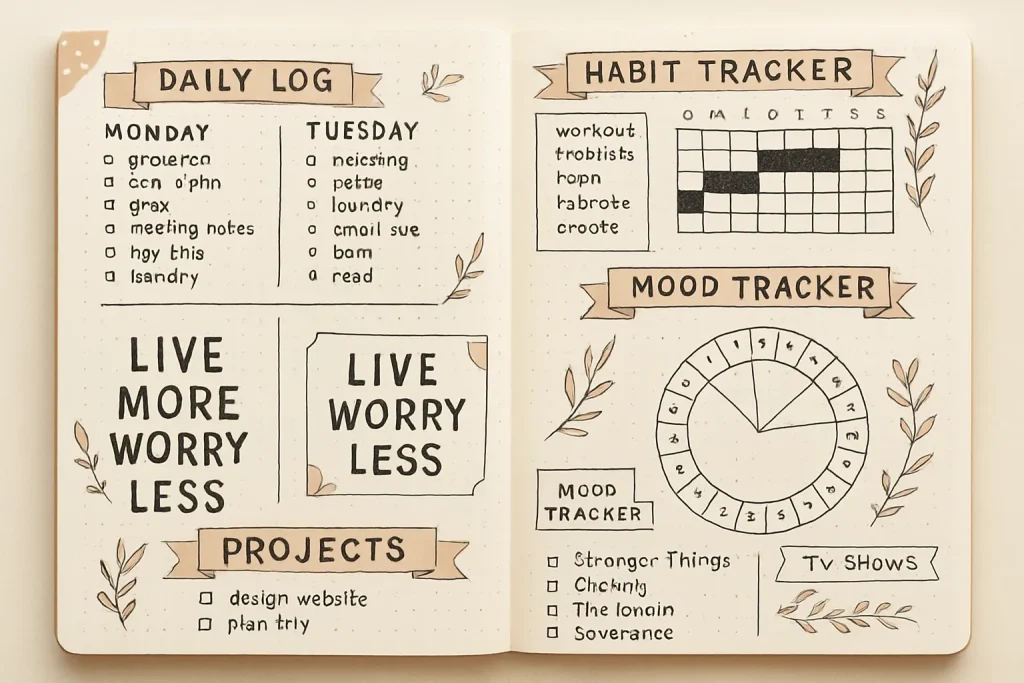
Have you ever started a bullet journal—filled with high hopes for organization and self-improvement—only to find it eventually abandoned, lost under a pile of half-finished notebooks?
If so, you’re not alone. Many embark on their bullet journal (BuJo) journey only to stumble at the first sign of inconsistency.
Over the last four years of bullet journaling, I’ve discovered not just the practical side of the BuJo method, but also the deeply personal relationship we can cultivate with this humble notebook.
In this blog post, I’ll dive deep into how to use your bullet journal effectively, why inconsistency is the number-one killer of a BuJo habit, and how, with the right mindset, your BuJo can become your most trusted friend—one that helps you organize not just tasks, but your entire mind.
Table of Contents
Why Bullet Journaling?
Before we dig into the “how,” let’s quickly remind ourselves: What makes the bullet journal special?
- Extreme Flexibility: Unlike pre-formatted planners, a bullet journal is a blank slate. It’s a system as simple or as complex as you need. Whether you’re building a tv show tracker bullet journal, a habit tracker, or a bullet journal for month planning, the options are endless.
- Mindfulness: Keeping a BuJo encourages intentional living, helping you focus on what matters and reflect on your progress—especially beneficial when you jot quotes in your bullet journal or track your mood with a mood tracker bullet journal.
- Productivity & Creativity: With daily logs, habit trackers, and space for brainstorming, it bridges the gap between productivity and self-expression. You can include anything from project management collections to your own bullet journal doodles.
The Silent Killer: Inconsistency
Let’s be honest: the euphoria of starting a bullet journal soon gives way to the grind of maintaining it. For many, inconsistency creeps in—missed days, ignored collections, blank pages. Over time, this can sap your motivation and lead you to abandon your BuJo altogether.
Why Does Inconsistency Hurt?
- Loss of Trust: If you aren’t jotting down everything, you lose faith in your own system.
- Clutter Returns: The mental mess you were trying to organize finds new places to hide.
- Guilt Spiral: Skipping entries leads to guilt, which makes you less likely to return to your BuJo, creating a vicious cycle.
The Golden Rule: Jot Everything Down
The most transformative habit you can adopt is simple: If it comes to your mind, jot it down in your bullet journal. Don’t second-guess, don’t worry about the layout, just capture it.
Why This Works
- Captures Fleeting Thoughts: Ideas, tasks, feelings—once written, they become tangible and actionable. Whether you want to put your ideas in bullet journal or track tv shows, your notebook becomes your memory.
- Unclutters the Mind: Freeing your brain from the burden of remembering every little thing.
- Establishes Consistency: The more you jot, the more natural it becomes, embedding the habit into your daily routine—making it easier to maintain a bullet journal.
Make Your BuJo Your Best Friend
Treat your bullet journal like your closest confidant. When you wake up, open it. Before work, have it nearby. Use it to organize your thoughts, vent frustrations, celebrate wins, and everything in between.
How to Do This
- Always Keep It Open: Let it be the first thing you look at in the morning and the last thing at night.
- No Judgment: Your BuJo is a judgment-free zone. Messy handwriting, crossed-out lists, half-finished pages—they’re all allowed. Even if you’re not artistic and just want to bullet journal in a planner or on lined paper, it counts.
- Talk To It: Write as if you’re chatting with a friend. Don’t worry about perfection; focus on honesty.
Practical Steps to Effective Bullet Journaling
1. Start With a Simple Setup
Don’t complicate things with elaborate spreads or trackers from the get-go. Simplicity is your friend.
- Index and Key: Start with a bullet journal index and a legend for your symbols—dots for tasks, circles for events, dashes for notes. Learn how to make a key for a bullet journal for better tracking.
- Future Log: A snapshot of your big-picture goals and events.
- Monthly & Daily Logs: Where the magic happens—jot down tasks, reminders, meeting notes, and observations.
2. Use Daily Logs Religiously
- Write your to-do list, intentions, or thoughts every morning.
- As the day unfolds, add impromptu tasks, random thoughts, or sketches.
- At night, review your entries—migrate what’s undone, reflect on what’s accomplished.
3. Embrace Imperfection
Bullet journals aren’t about beauty; they’re about utility. If you skip a day, misspell a word, or smudge ink, just turn the page and start again. Forgive yourself for missed days—use washi tape in your bullet journal to cover mistakes, or decorate a new page to renew motivation.
4. Make Task Lists
- Use short bullets for actionable tasks.
- Break big projects into smaller subtasks—great for bullet journal project management.
- Review and migrate incomplete items at the end of each day or week.
5. Build Collections
Collections are essentially themed lists or logs—books to read, movies to watch, creative ideas, meal planning, fitness tracking, or even a tv show tracker bullet journal.
- Reserve a few pages for collections that matter to you.
- Add new collections as your needs evolve—like a bullet journal for weight loss, or as a tool for work.
Developing the Habit: Make It Natural
The secret to bullet journaling is the daily ritual. Make it as necessary as brushing your teeth.
- Pair with another habit: Review your BuJo with your morning coffee or before you start work.
- Leave it Visible: Keep your BuJo open on your desk or bedside.
- Set Reminders: Until it becomes automatic, use gentle nudges on your phone or sticky notes.
- Stay Motivated: Create fun layouts, try bullet journal printables, keep your bullet journal app handy, or make bullet journals on Android or iPhone when you’re on the go.
With consistent practice, writing in your BuJo will no longer feel like a chore, but a natural extension of your thinking process.
Problem Solving: What If You Lose Momentum?
If you find yourself slipping, don’t feel ashamed. Here are ways to bounce back:
- Open the Journal: Sometimes just opening it is enough to break the spell.
- Review Recent Pages: Rekindle your sense of purpose by seeing past accomplishments. Flip through old spreads, meeting notes, or mood tracker bullet journals and rediscover your progress.
- Start Fresh: Begin with today—a new log, a new page, a new thought.
Real-Life Reflections: Four Years In
After four years of bullet journaling, one lesson stands out above all: Your BuJo is only as effective as your commitment to use it honestly and consistently. There’s no right way—only your way. What matters most is honoring the act of capturing what matters to you.
For me, my BuJo is a roadmap, a safety net, and a creative canvas—all in one. It keeps chaos at bay and helps me chart a path through the busiest of days. The more I trust it—by jotting down every thought, without hesitation—the more reliable and trustworthy it becomes.
Conclusion: Let Your BuJo Work For You
To use a bullet journal effectively, shift your mindset: see it not as an obligation, but as a relationship. Your BuJo is always ready to listen, capture your thoughts, and help you organize your world.
Make consistency a priority.
Write everything, no matter how trivial.
Forgive yourself for missed days.
Let the habit take root—one entry at a time.
Soon, you’ll discover your bullet journal isn’t just a planner, but a partner in life—a best friend you can rely on, rain or shine.
Happy journaling!
Bonus: Integrate and Customize Your Bullet Journal
- Digitize: Make a digital bullet journal in Evernote, on your phone, on Android, or with a BuJo app.
- For Students: Set up a bullet journal for school or as a minimalist bullet journal to keep things streamlined.
- Achieve Goals: Start a bullet journal for beginners focusing on goal-setting, or combine your bullet planner with a personal journal.
- Decorate & Personalize: How to decorate your bullet journal cover, draw bullet journal headers, banners, and add washi tape for flair.
- Work Use: Use your bullet journal for work—track projects, take meeting notes, manage tasks efficiently.
- Handwriting & Calligraphy: Practice bullet journal calligraphy or improve your handwriting for a neat finish, but remember utility matters more than aesthetics.
- Layout & Indexing: Learn how to layout your bullet journal, add pages, and create a bullet journal index for easy navigation.
- Creative Extras: Try bullet journal doodles for fun, make a calendar, or decorate the first page of your project bullet journal.
- Alternative Tools: Use Trello as a bullet journal, bullet journal in a planner, start in Keynote, or create in OneNote.
No matter your style, preferences, or needs, there’s a bullet journal option to help you stay organized, creative, and motivated.

